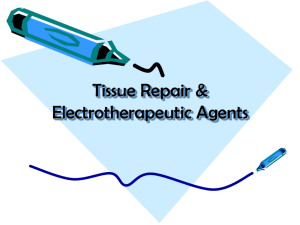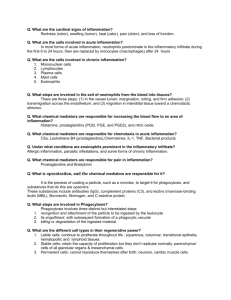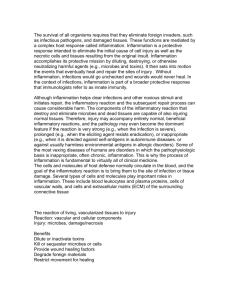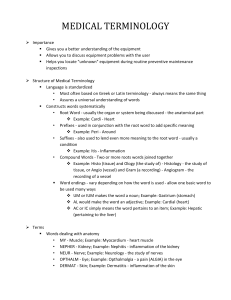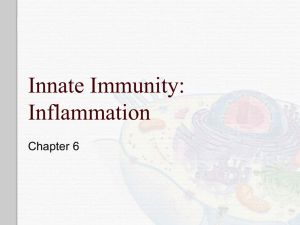Pathophysiology
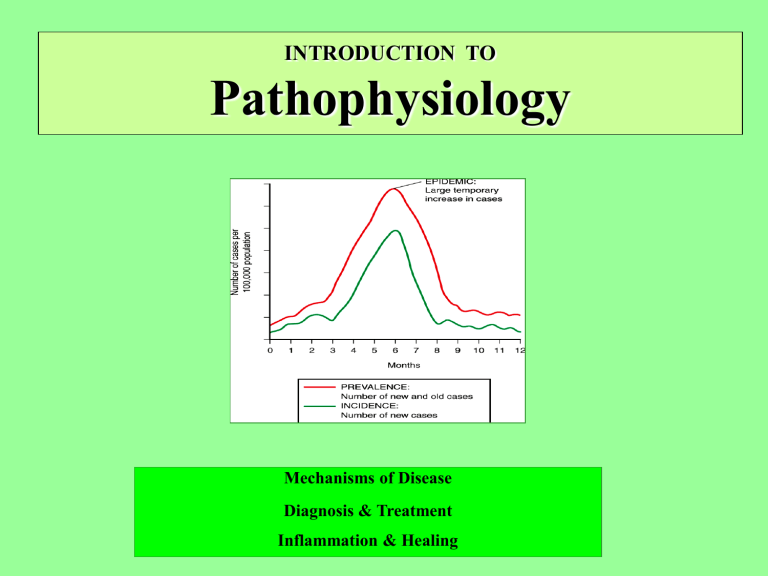
INTRODUCTION TO
Pathophysiology
Mechanisms of Disease
Diagnosis & Treatment
Inflammation & Healing
Terms Used In Pathophysiology
• Pathology = study of disease
• Pathogenesis = the development of a disease
» Diseases develops in stages
» Infectious disease example:
(A)incubation (b)disease (c)convalescence
• Pathophysiology = the study of the functional changes associated with a specific disease
» How the disease affects specific functions of the body
• Subjective findings
» The patient’s symptoms
» Described by the patient----( the patient’s history )
• Objective findings
» Health provider’s findings---( the physical exam )
• Occurrence of disease defined by 2 factors
• Incidence = # new cases per unit of time
• Prevalence = # new & old cases per unit of time
•
Disease terminology
– Etiology = cause of the disease
– Idiopathic = disease with unknown cause
–
Iatrogenic = disease caused by human intervention
– Congenital diseases = diseases occurring at birth
– Syndrome = common cause of different signs & symptoms
– Remission = period when symptoms & signs of disease abates
–
Exacerbation = period when symptoms & signs increase
–
Endemic disease = disease native to local area
– Epidemic = many people affected in a given area
– Pandemic = many people affected in large areas
– Incubation = latent period of the disease before develop signs & symptoms
–
Prognosis = probability for recovery
– Morbidity = disease rates within a group
– Mortality = death rates within a group
– Epidemiology = how the disease occurs & spreads through an area
Predisposing Factors (risk factors)
•
Age
• Young are prone to accidents
• Getting diseases such as diabetes, heart disease, and certain cancers increase with age
• Very old are prone to drug interactions
•
Sex
• More frequent in woman: MS, osteoporosis
• More frequent in men: gout, Parkinson’s disease
•
Lifestyle
• Examples of harmful lifestyle:
» Perilous occupation
»
Smoking
»
Excess alcohol
» Poor nutrition
»
Sedentary activity
•
Environment
• Air pollution
• Water pollution
•
Poor living conditions
• Excessive noise
• Chronic psychological stress
•
Heredity
• Deals with genetic predisposition (inheritance)
» Genetic predisposition + certain type of environment = mental retardation , lung cancer, etc.
•
Preventive health care
•
The best treatment of a disease is prevention !!
•
Deals with altering risk factors that can be changed
Homeostasis
• Definition = internal constancy or a stable internal environment
• A “body in balance” is in homeostasis
• Homeostatic regulation ---- works by using feedback loops
•
Feedback loops
utilize 3 components
(1) receptor (2) control center (3) effector
–
2 types of feedback loops
(1) negative feedback
– Restores any change back to normal
– Resembles “teeter-totter”
– Stabilizing
– Most common
(2) positive feedback
–
Exaggerates the change
– Resembles “domino effect”
–
Stimulating
–
Least common
• Homeostasis & disease
– Disease is the failure to maintain homeostatic conditions
•
Disease mechanisms
– Genetic = mutated or abnormal genes
– Pathogens (microscopic organisms)
– Loss of control mechanisms (e. G. Diabetes, immune problems)
–
Degenerative changes (normal aging)
– Environmental hazards (trauma, chemicals)
– Nutritional factors
– Tumors (benign & malignant)
The Cell & Disease
Changes in Growth
• Changes in
size
of individual cell
– Atrophy = decrease in cell size
– Hypertrophy = increase in cell size
• Changes in actual
number
of cells
– Hyperplasia, Dysplasia, & Anaplasia = increase in rate of reproduction
– Hyperplasia = increase in number of normal cells
– Dysplasia = increase in number of atypical cells
–
Anaplasia = increase in number of frankly abnormal cells
Change in Type of Cell
• Change of one type of cell into another type
(metamorphoses)
– Metaplasia = change to different mature cell type
•
Cell damage is the main reason to lose homeostasis
– Deficiency of oxygen (hypoxia) = most common reason
• Mechanism of progression:
ischemia
-to-
necrosis
-to-
gangrene
•
Cell death
– Once it occurs, lysis occurs with release of lysosomal enzymes
• This causes inflammation
•
After inflammation, the dead cells(tissue) is either:
• Replaced by scar tissue
• Regenerated to resemble original tissue
Diagnosis & Treatment
• “SOAP” protocol:
“S” = subjective “O” = objective “A” = assessment “P” = plan
•
Subjective Findings = the patient’s symptoms
•
Obtained by taking a medical history
– includes:
»
Chief complaint (cc)
» present illness (PI)
» past history (PH) ------- med/ surg/ allergies/ lifestyles
» family history (FH)
» review of systems (ROS)
• Objective Findings = the patient’s physical manifestations
•
Obtained by doing a physical exam
– Begins with opening statement
(WD/WN/WW)
–
Then vita signs ------ T, P, BP, RR, Pain
– go from head to toes!
–
Includes techniques of:
» inspection
» auscultation
» palpation
» percussion
• Assessment = arriving at a diagnosis
–
Differential diagnoses
• Includes all possibilities
–
Lab
•
Basically a study of body fluids
– Diagnostic tests
•
Imaging
»
X-ray, US, CAT, MRI, isotope scans
• Endoscopies
•
Biopsies
•
Skin tests
• Plan = all possible treatments with associated complications & prognoses
• Includes a “Treatment Plan”
– individualize
– modalities available:
» do nothing (primun non nocere)
» Talk (counseling)
»
Medication
»
Surgery
•
Includes a Prognosis
The Inflammatory Response
• Key purposes = DEFENSE
1.
To hunt & kill invaders
2.
To limit their spread
3.
To prepare tissue for repair
• Key events
1.
Increase of vascular permeability
2.
Recruitment (margination) & emigration (diapedesis) of WBC’s
3.
Phagocytosis
The Inflammatory Response
• Inflammatory response = normal body defense mechanism to tissue injury
» Note: Inflammation is NOT infection
•
Cells of the inflammatory response when get tissue injury
– Main groups;
•
Phagocytes --- “the eaters”
–
Macrophages --- become active as APC’s (antigen presenting cell)
– Neutrophils --- “little eaters”
–
Monocytes --- become tissue macrophages
•
T- lymphocytes ( helper-T ) ---- produce cytokines which “ call all to action”
•
Platelets ---- release PAF (platelet activating factor) which in turn begins call to action and release of chemical mediators
• Mast cells --- release chemical mediators that begin inflammation
Chemical Mediators
• The initial “macrophage (APC cell) – antigen complex” causes chemical mediators to be released:
– Histamine
•
From basophils & mast cells
• Cause vasodilation & increased permeability of vessels via release of nitric oxide
– Prostaglandins
• Made in mast cell membrane from fatty acid (arachidonic)
• Cause pain & vasodilation
– Leukotrienes
• “bad” prostaglandins since cause symptoms of inflammation (pain
& swelling)
• Cause chemotaxis
•
Very important for causing allergies, asthma, & anaphylaxis
Chemical Mediators
– Complement
• Coats bacterial surface; enhances phagocytosis & lyses bacteria
•
Inactive plasma proteins become activated by initial An-Ab complex
– Interferon
• Proteins that are released by helper T’s & kill viruses
– Bradykinins
• From inactivated plasma protein
• Cause similar effects like histamine
• Cause pain
• Induce WBC’s into area (chemotaxis
• Local effects of inflammation
–
4 cardinal signs of inflammation
• Redness (rubor) – from increased blood supply
• Heat (calor) – from increased blood supply
• Swelling (tumor) – from increased permeability & increased proteins in interstitial fluid
•
Pain (dolar) – from chemical mediators
– Also get inflammatory exudate
• Serous – from allergic reactions & burns
• Purulent – from infections
–
May lead to abscess
• Systemic effects of inflammation
– General malaise
–
Fatigue
–
Headache
–
Fever
•
Caused by pyrogens (chemicals released from phagocytes)
•
Beneficial
–
Inhibits growth of pathogens
– Enhances repair process via increased metabolic rate
• Leukocytosis
•
Chemotaxis
•
Margination
•
Diapedesis
• Potential complications of inflammation
•
Infection
• Ulceration – from chronic inflammation
– May lead to:
» perforation of viscera
» excess scar formation
•
Skeletal muscle spasm
•
Local tissue reactive changes
–
Joints from decreased ROM become stiff
–
Lungs cannot exchange gases
• Diagnostic tests for inflammation
•
Leukocytosis
•
Differential WBC count
•
ESR
•
Cell enzymes – may or may not be tissue specific
– C-reactive protein
• Chronic Inflammation
–
The acute inflammatory reaction usually subsides within 48 –72 hours as long as the cause is removed (e.g. touching a hot stove)
–
If the cause persists, you get chronic inflammation
–
Clinically:
•
Increase in connective tissue reaction to the chronicity
–
Get more fibroblasts & more collagen
» Thus get more scar tissue
»
Can get granulomas (collection of chronically inflamed tissue)
• Treatment of inflammation
•
Aspirin
• NSAID’s
•
Glucocorticoids
•
Heat & cold
• Physiotherapy if chronic
» Prevents contractures
Healing
• 3 ways depending on the tissue involved & degree of injury
–
Resolution
• Damaged cells recover in short time
• Exp = mild sunburn
– Regeneration
•
Damaged cells replaced by identical cells via mitosis
•
Only occurs in epithelia & connective tissue
•
If complex organ, some damaged tissue replaced by regeneration
& some by scar
– Scar formation
• Key tissue = granulation tissue(highly vascular connective tissue)
»
Collagen produced by fibroblasts makes granulation tissue into scar tissue
• Scar tissue is non-functional
•
Healing by primary or secondary intention
– Depend weather edges of lesion can be brought together
– Primary (first) intention gives small scar formation
– Secondary intention gives large scar formation
– Heals via granulation tissue
• Complications from large scar formation
(see next slide)
– Loss of function
–
Contractures & obstructions
•
Can lead to stenosis
– Adhesions
–
Ulceration
• Factors promoting healing
• Nutrition
•
Blood supply
•
Cleanness of area
• Lack of complications
• Factors delaying healing
• Old age
• Presence of foreign material
•
Poor blood supply
• Poor nutrition
•
Complications (bleeding, hematoma, excessive mobility)
• First degree burns
–
Superficial partial-thickness
– Involves just epidermis
–
Get redness but no blistering
–
May peel in 1-3 days
– Get no scarring
• Second degree burns
–
Deep partial-thickness
– Involves epidermis & dermis
–
Get redness & blistering
–
Can get scarring
– Can get some fluid loss
–
Get significant pain
•
Third degree burns
–
Full-thickness
–
Involves all 3 layers & may involve underlying tissue
–
Get no pain
– Get serious fluid loss
Burns
• Rule of 9’s
–
If burn 1 st ,2 nd , or 3 rd & involves more than 20% ---needs medical attention
– If burn 2 nd or 3 rd & involves greater 20% = serious
–
If burn 2 nd or 3 rd & involves greater 40% = severe
• Complications
–
Fluid imbalance
–
Dehydration
–
Anemia
–
Infection
– Excess scar formation
